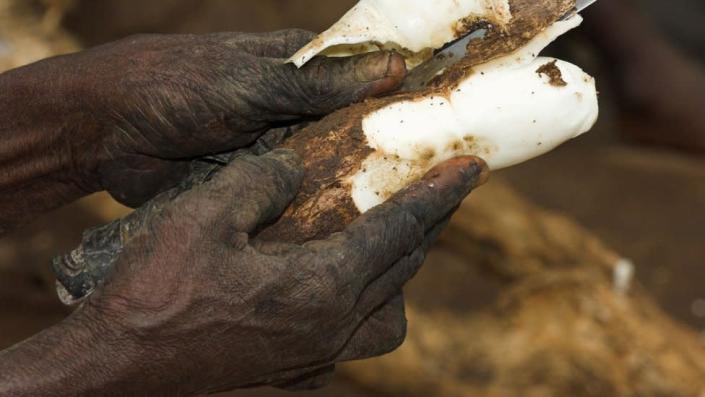Why cassava could be a way to keep food costs down
[ad_1]

In our series of letters from African journalists, Ghanaian Elizabeth Ohene considers the phone of Uganda’s President Yoweri Museveni for individuals to eat the humble cassava as the value of wheat soars close to the entire world.

There are two most important root greens in West Africa – cassava and yam.
Cassava is readily available all calendar year round, it is low-cost and is acknowledged, or to set it accurately, was known as food for the inadequate.
The other popular one particular is yam, which Nigerian author Chinua Achebe famously explained as “the king of crops”.
The yam harvest is awaited eagerly. Certainly, distinctive rites are done prior to the new yam can be eaten, and we set on our best clothes to rejoice the vegetable.
Cassava is, at ideal, each day foodstuff and utilized to be the regular fare of the poor and servants.
I take note that President Yoweri Museveni of Uganda is urging his people today to transform to a diet program of cassava as an antidote to the rocketing selling price of wheat throughout the existing around the globe expense of dwelling disaster.
“If there is no bread, take in muwogo [cassava],” he said.

Mr Museveni’s comments have triggered controversy, with critics stating he has no actual program to offer with the price tag of dwelling disaster.
Over in this article in Ghana, we experienced a finance minister who, way again in the 1960s, tried out to justify a proposed boost in taxes by stating the bad would not be affected because they ate gari – a popular granular flour produced from processed cassava.
At the time, gari was regarded largely as food stuff for the weak and the minister produced the stage that if you additional water to fifty percent a cup of gari, it would swell to give adequate meals for three men and women. It was inexpensive and filling.
The minister was also building the place, devoid of indicating it aloud, that poor people today didn’t consume bread or rice, or other these kinds of extravagant imported foods. This was mainly legitimate at the time.
Many years later, we experienced a minister of state who addressed increasing food charges by declaring people today could normally take in kokonte, which he cited as a low-cost alternate to rice and other imported foods.
Kokonte is produced from cassava flour and, like all factors cassava, was acknowledged as food stuff eaten by the lousy.
President Museveni created the level that he ate cassava. In other phrases, nobody should really be ashamed of feeding on, or seen to be taking in, cassava due to the fact it was now presidential food stuff.
These days, the drought-resistant crop is also touted as having overall health added benefits – cassava root is gluten-free of charge, large in vitamin C and loaded in copper.

I don’t know if cassava stays branded as foods for the weak in Uganda, but in Ghana, we have arrive a long way.
Get gari. It get rid of its picture as foodstuff for servants and the inadequate when it turned the indispensable companion of all boarding school learners.
They go to school with a bag of gari in their “chop box”. The various meals they make with gari in dormitories are named soakings.
It can be a fast and uncomplicated approach, demands no cooking or microwave oven for heating – you place some gari in a cup, add h2o, sugar and milk, combine it and that’s it. You have the most mouth watering and filling snack.
The savoury alternate is more common and will involve taking about a cup of dry gari, sprinkling a little bit of h2o on it to soften it, including a tablespoonful of our renowned peppery sauce, shito, adding a tin of sardines, mixing it all up – and hey presto, you have a different delightful food. I really don’t know why but this a person appears greatest eaten in a team.
But gari really became the supreme haute-delicacies item when Ghana’s famous caterer, Barbara Baeta, devised a recipe for “gari foto” – gari blended with gravy and seafood, which she served at a point out banquet in 1970 hosted by Prime Minister Kofi Abrefa Busia.
Out of the blue gari experienced develop into foodstuff that was served at gatherings for the high and
mighty and it was modern.

In some means, the different food items manufactured from cassava have been reworked into meals that men and women boast about eating.
It’s not as opposed to the emergence in the 1960s of what African Individuals termed soul food, when they embraced what they ate as slaves and turned it into stylish and desirable foodstuff.
I assume there is scope for some adventurous Ghanaian caterers to go to Uganda and establish restaurant chains that would provide only cassava-spinoff food items.
And I hope that by the time the insanity in Ukraine is above, cassava will grow to be the foodstuff of alternative across Africa and we shall leave wheat to these who develop it.
There might not be a Chinua Achebe all around to wax lyrical about cassava, we may possibly not rejoice cassava festivals but no-a single would at any time refer to it all over again as foodstuff for the bad, and President Museveni is not going to have to make speeches to really encourage his individuals to consume cassava.
Extra Letters from Africa:
Follow us on Twitter @BBCAfrica, on Facebook at BBC Africa or on Instagram at bbcafrica

[ad_2]
Source url
